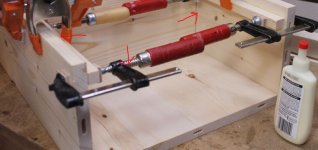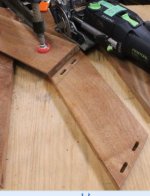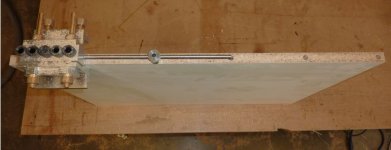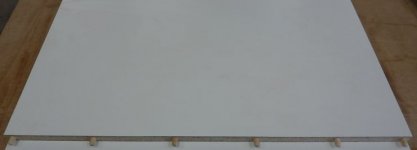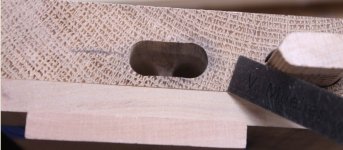You are using an out of date browser. It may not display this or other websites correctly.
You should upgrade or use an alternative browser.
You should upgrade or use an alternative browser.
No Domino Joiner? No problem
- Thread starter ChuckS
- Start date
Packard
Member
I have an early version of Rockler's Beadlock jig. It works about the same in terms of ease of use and time required.
But if I have a lot of pieces to do, I find it faster to just make regular mortise and tenons. (I have a Dewalt tenoning jig and a Dewalt mortising machine). But for just two or three joints, I always go back to the Beadlock or dowels (or pocket holes or biscuits).

But if I have a lot of pieces to do, I find it faster to just make regular mortise and tenons. (I have a Dewalt tenoning jig and a Dewalt mortising machine). But for just two or three joints, I always go back to the Beadlock or dowels (or pocket holes or biscuits).

One often overlooked feature of the Domino machine is its math-free ability to do partitions and dividers so efficiently. Imagine doing dowels or using some kind of a router jig to complete the joint on these three sides in the exact position as desired:
[attachimg=1]
[attachimg=1]
Attachments
Packard
Member
My CMT dowel jig allows that also.
At position 3:48 on the video shows the jig. I have these jigs. It shows the centerline for the shelf. It actually shows the centerline for a 20mm shelf. So it is off about 0.020" with our nominal 3/4" thick panels and a bit more off on MDF and particle board which is actually 3/4" thick.
At position 3:48 on the video shows the jig. I have these jigs. It shows the centerline for the shelf. It actually shows the centerline for a 20mm shelf. So it is off about 0.020" with our nominal 3/4" thick panels and a bit more off on MDF and particle board which is actually 3/4" thick.
If I understand the CMT jig correctly from the video, one needs to drill center holes on the partition (on three edges, endgrain) with a drill centering jig, locate and mark the center lines on the sides (carcase), and clamp CMT jig in position and drill holes.
With the Domino machine, only one positioning is needed: Clamp where you want the partition to be on the side, and mortise both the partition and side with the same machine setting. That's it. No jigs needed. Plus, easy peasy on angled dividers, even narrow ones, because you don't need to reference against any edges:
[attachimg=1]
With the Domino machine, only one positioning is needed: Clamp where you want the partition to be on the side, and mortise both the partition and side with the same machine setting. That's it. No jigs needed. Plus, easy peasy on angled dividers, even narrow ones, because you don't need to reference against any edges:
[attachimg=1]
Attachments
Steve1
Member
Looks good.
I am planning something similar. But I am waiting for my new router to come in, and its on back-order.
I am planning something similar. But I am waiting for my new router to come in, and its on back-order.
Packard
Member
ChuckS said:If I understand the CMT jig correctly from the video, one needs to drill center holes on the partition (on three edges, endgrain) with a drill centering jig, locate and mark the center lines on the sides (carcase), and clamp CMT jig in position and drill holes.
With the Domino machine, only one positioning is needed: Clamp where you want the partition to be on the side, and mortise both the partition and side with the same machine setting. That's it. No jigs needed. Plus, easy peasy on angled dividers, even narrow ones, because you don't need to reference against any edges:
[attachimg=1]
I clamp the jig to the edge of the shelf and drill the dowel holes. The Domino makes slots in the edge of the panel
I draw a line indicating the location for the shelf. I clamp the template and drill the holes. You draw the location for the shelf and make the slots.
I glue and insert the dowels. The dominoes are glued and inserted.
I assemble and clamp. The domino unit is assembled and clamped.
The steps are essentially the same.
The difference is that I clamp once for each joint. The domino has to be relocated for each slot.
I considered the domino, but I have several dowel jigs and I am comfortable with them. The CMT jigs are just for sheet goods. I have other jigs for other applications.
Oh, and dowels are cheaper than dominoes.
Packard said:Snip.
The steps are essentially the same.
Snip.
That's true in terms of steps, but not necessarily so in terms of simplicity and efficiency.
The Domino Joiner isn't cheap, but in that partitioning application I referred to above, no dowel or router method can match its efficiency. That is true whether we're making one divider or 10 of it. In my earlier comment, I was clear and very specific about the machine's efficiency, not its cost of acquisition or running.
Are you referring to the ability to register (paddles and cross stops)? Many doweling jigs have that feature. Dowelmax is very efficient in that regard. Completing joint as on the picture would be a breeze.ChuckS said:One often overlooked feature of the Domino machine is its math-free ability to do partitions and dividers so efficiently. Imagine doing dowels or using some kind of a router jig to complete the joint on these three sides in the exact position as desired:
I was referring to the Domino machine's ability to mill mating mortises on a divider or board AND on the carcase with ease in one single procedure. One machine and no jigs or accessory needed. The operation is done on the two mating pieces in the same setting.Svar said:Are you referring to the ability to register (paddles and cross stops)? Many doweling jigs have that feature. Dowelmax is very efficient in that regard. Completing joint as on the picture would be a breeze.
For the Dowelmax (based on my Google search, not usage experience as I don't have one), it'd involve making holes on the divider or board and then making holes on the carcase. That's two operations. I don't see how it can be more efficient than the DF500.
[attachimg=1]
[attachimg=2]
Attachments
Packard
Member
Milescraft dowel jig, a very basic jig, can do that. It costs $22.00. I have one and it works just as shown.
Look at minute 5:40 in this video.
Look at minute 5:40 in this video.
Lot's of doweling jigs do that too. Milescraft, as already mentioned, Jessem, plenty of others. It's actually better in some way, since you register directly from the mating hole/dowel, not from the edge or pencil mark. Overall not as fast as Domino, because of clamping/unclamping, but close.ChuckS said:I was referring to the Domino machine's ability to mill mating mortises on a divider or board AND on the carcase with ease in one single procedure. One machine and no jigs or accessory needed. The operation is done on the two mating pieces in the same setting.Svar said:Are you referring to the ability to register (paddles and cross stops)? Many doweling jigs have that feature. Dowelmax is very efficient in that regard. Completing joint as on the picture would be a breeze.
Packard
Member
My only point was that Domino does not have ownership on that technique.
If you like dowels, then it is available in that system.
For narrow planks, the Domino is probably faster than the CMT. But on wide planks, (20" or more), I think the CMT system is quicker.
If you plan on going into production, then dowels are going to be faster because automation exists for dowels.
If you like dowels, then it is available in that system.
For narrow planks, the Domino is probably faster than the CMT. But on wide planks, (20" or more), I think the CMT system is quicker.
If you plan on going into production, then dowels are going to be faster because automation exists for dowels.
Packard said:My only point was that Domino does not have ownership on that technique. Snip
????
Who has made that claim?
Loose M&T has also existed long before the invention of the Domino machine.
Crazyraceguy
Member
- Joined
- Oct 16, 2015
- Messages
- 5,078
Yes, the dowel machine we use will drill, glue, and insert the dowels so fast that you can barely see it happen. It is however a one-trick-pony. It only does the edge part and you could buy dozens of Domino machines for what it costs. It is lightening fast and anyone can do it. Scan a sticker, push the part against the stops, push the button, done. If you have a lot of identical parts, you can skip the scanning step after the first one.Packard said:My only point was that Domino does not have ownership on that technique.
If you like dowels, then it is available in that system.
For narrow planks, the Domino is probably faster than the CMT. But on wide planks, (20" or more), I think the CMT system is quicker.
If you plan on going into production, then dowels are going to be faster because automation exists for dowels.
A CNC machine is doing the holes in the adjacent parts. This could be done on and old-school "point-to-point" machine at a much lower cost, but still nowhere near hobbyist range.
The Domino is a fantastic machine, I use mine a lot, but as a home/hobby woodworker it would take a lot to justify its cost.
Steve1
Member
This is my Domino Jig.
Its got a nice wide front block, so my router sits stable, flush with the top of my workpiece. Actually, you will notice there is a block at the center-rear of my jig that is also flush with the top of the workpiece. So router is very stable when slotting a 3/4" wide board. My parallel guide has an opening in it to allow for the rear-center block to support my router.
On a wide board, the jig just automatically sits flush with the top of the workpiece. Its stable, but just the same, I C-clamp the jig to the board before cutting. On a narrow board, I can attach a strap clamp to hold the workpiece -- you can see one of the 1/2" clamp bolts near the top of photo 4.
For the mating board (the piece on the right, in photo 6), my parallel guide is already in the perfect position for cutting it. But to cut slots in the middle of a wide board, I would have to cut them with my router on a track sled.
Its got a nice wide front block, so my router sits stable, flush with the top of my workpiece. Actually, you will notice there is a block at the center-rear of my jig that is also flush with the top of the workpiece. So router is very stable when slotting a 3/4" wide board. My parallel guide has an opening in it to allow for the rear-center block to support my router.
On a wide board, the jig just automatically sits flush with the top of the workpiece. Its stable, but just the same, I C-clamp the jig to the board before cutting. On a narrow board, I can attach a strap clamp to hold the workpiece -- you can see one of the 1/2" clamp bolts near the top of photo 4.
For the mating board (the piece on the right, in photo 6), my parallel guide is already in the perfect position for cutting it. But to cut slots in the middle of a wide board, I would have to cut them with my router on a track sled.
Attachments
-
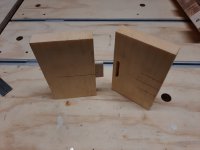 6 - Small Parts Cut.jpg1.4 MB · Views: 176
6 - Small Parts Cut.jpg1.4 MB · Views: 176 -
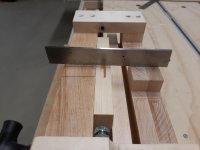 5 - On Small Part.jpg1.3 MB · Views: 184
5 - On Small Part.jpg1.3 MB · Views: 184 -
 4 - Small Part Strap Clamped.jpg1.6 MB · Views: 173
4 - Small Part Strap Clamped.jpg1.6 MB · Views: 173 -
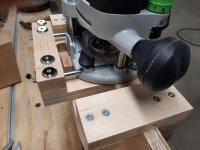 3 - On Panel.jpg1.5 MB · Views: 179
3 - On Panel.jpg1.5 MB · Views: 179 -
 2 - On Panel - Front.jpg1.4 MB · Views: 170
2 - On Panel - Front.jpg1.4 MB · Views: 170 -
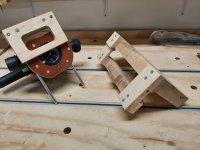 1 - Jig - Both Pieces.jpg1.4 MB · Views: 180
1 - Jig - Both Pieces.jpg1.4 MB · Views: 180 -
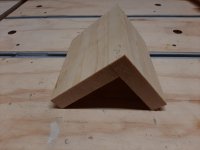 7 - Small Parts Assd.jpg1.3 MB · Views: 172
7 - Small Parts Assd.jpg1.3 MB · Views: 172
Crazyraceguy said:Snip.
The Domino is a fantastic machine, I use mine a lot, but as a home/hobby woodworker it would take a lot to justify its cost.
Most of the woodworkers I know who own Festool stuff (Domino, TS, dust extractors, etc.) and other fancy or premium hand tools are all hobbyists. Among the four fellows/shops that I befriend who do cabinetmaking or house reno for a living, or own a furniture shop, only two of them own Festool or Mirka (TS55, dust extractors and sanders), but no Festool routers or Kapex. Theirs are mostly Bosch, DeWalt, Ridgid, Hitachi kind of stuff, even though they can claim their purchases as tax deductibles.
This is one of the places where I get my thick lumber (2" and over), which also produces furniture such as tables and chairs, including Sam Maloof style rockers, in the shop at the back. They have four full-time furniture guys plus a designer, but I have never seen anything Green or Orange. They ship chairs and huge dining and conference tables to customers with deep pockets in the States in custom crates. (Look at the socks in the chairs.) This shop competes for the kind of customers who buy from Ethan Allen or the corporate kind. Last time when i was there (2021 Sept.). they had a conference table (size good for 20 people) in the furniture room (next to its showroom) waiting to be packaged and shipped.
[attachimg=1]
Crazyraceguy
Member
- Joined
- Oct 16, 2015
- Messages
- 5,078
My point was that the main advantage of the Domino machine itself is the speed/simplicity of it, which makes sense in a commercial environment. As has been demonstrated many times, there are plenty of other ways to accomplish the same type of joinery with router jigs. So, a guy in his home shop might want to go that way. Then again are the ones with limited time in the shop, the speed factor would appeal to that type of woodworker. They can get more done on a project, rather than building jigs.
It's all about what you are doing in the shop, how often you would need it, and of course financial constraints.
I'm sure that there are people out there who could really benefit from having one, but can't or just won't buy one. I would bet the reverse is true too.
It's all about what you are doing in the shop, how often you would need it, and of course financial constraints.
I'm sure that there are people out there who could really benefit from having one, but can't or just won't buy one. I would bet the reverse is true too.
Crazyraceguy said:My point was that the main advantage of the Domino machine itself is the speed/simplicity of it, which makes sense in a commercial environment. As has been demonstrated many times, there are plenty of other ways to accomplish the same type of joinery with router jigs. So, a guy in his home shop might want to go that way. Then again are the ones with limited time in the shop, the speed factor would appeal to that type of woodworker. They can get more done on a project, rather than building jigs.
It's all about what you are doing in the shop, how often you would need it, and of course financial constraints.
I'm sure that there are people out there who could really benefit from having one, but can't or just won't buy one. I would bet the reverse is true too.
From the moment Festool released the Domino I said it was mainly aimed at the commercial operators and the home user was the cream on the cake for Festool. We as home users don't see the commercial selling side of Festool especially in the automotive smash repair industry.

